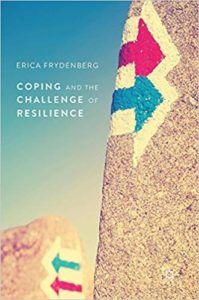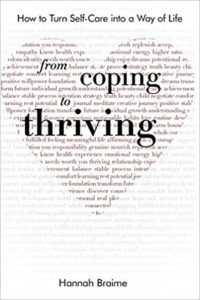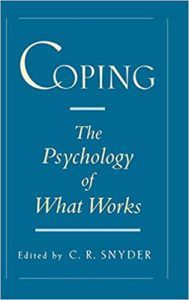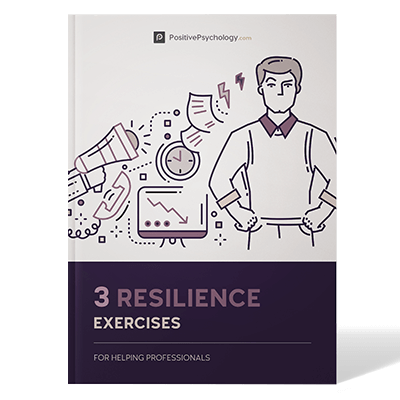What is Coping Theory?
 What is your first reaction in the face of sudden stress? Do you make a plan to overcome it?
What is your first reaction in the face of sudden stress? Do you make a plan to overcome it?
Talk it out with your friends? Avoid confronting the situation? Or try to hide the fear by resorting to comfort food or other substances?
There are so many different ways of adapting to a stressful situation. Coping is the conscious and unconscious efforts we put in to solve problems and reduce stress. It is the mind’s built-in troubleshoot program that aims to restore its optimum functioning state.
In psychology, coping skills or coping strategies are a set of adaptive tools that we proactively administer to avoid burnout. These tools can be our thoughts, emotions, and actions and are dependant on our personality patterns.
For example, a sociable and friendly person is more likely to use solution-focused and communication-based coping skills for getting rid of his troubles. On the contrary, a timid person has chances of using defensive and self-oriented coping strategies for psychological adjustments.
This article overviews the coping theory and explores how it works. It has practical examples and evidence and conjoins exciting activities for assessing one’s coping skills.
Lazarus and Folkman (1984), one of the pioneers of the coping theory, defined coping as:
constantly changing cognitive and behavioral efforts to manage specific external and internal demands that are appraised as taxing or exceeding the resources of the person.
Based on their definition, we can say that:
- Coping involves spending mental energy in a way that can reduce stress.
- Whether conscious or subconscious, the ultimate goal of all coping mechanisms is to solve a problem and return homeostasis.
- Coping strategies can be positive or negative, depending on whether they increase or reduce mental wellbeing.
- Coping is dependent on personality patterns and perceptual experiences.
- The strategies one choose for adapting to a situation is highly individualized. Coping is never the same for two people.
Before you read on, we thought you might like to download our 3 Resilience Exercises for free. These engaging, science-based exercises will help you to effectively cope with difficult circumstances and give you the tools to improve the resilience of your clients, students, or employees.
This Article Contains:
What is Coping Theory?
The coping theory is a vast area of study that is classified into two independent parameters:
- Focus-oriented theories (trait and state).
- Approach-oriented theories (micro-analytic and macro-analytic).
The focus-oriented state and trait theories of coping recognize a person’s internal resources and mental capacities for evaluating how well he can adapt to a situation. On the other hand, the approach-oriented micro and macro analytic coping theories revolve around how concrete or abstract the coping mechanisms are (Carver, Scheier, & Weintraub, 1989).
Macro-analytic trait-oriented coping theories
1. Repression-sensitization
This theory explains that coping happens along a bipolar dimension with repression at one end and sensitization at the other. People who cope by repression tend to deny or ignore the presence of a stressor to minimize its effect. On the flip side, sensitizers tend to react with extreme thoughts, worrying, and obsessive impulses to cope with the sudden encounter (Cohen & Lazarus, 1979).
2. Monitoring and Blunting Theory
This theory explains that one can reduce the impact of a stressful stimulus by using his cognitive processes. Blunting mechanisms such as denial, restructuring, and distraction help overlook temporary stressors. Monitoring strategies, including information processing and emotional management, are more helpful for dealing with ongoing negative stress and anxieties.
3. Model of Coping Modes (MCM)
This theory is an extension of the monitoring-blunting model and has some connections to the repression-sensitization theory. It expands on the concept of cognitive avoidance and suggests that we are naturally inclined to avoid a stressful situation and perceive it as ambiguous.
Macro-analytic state-oriented theories
The defense mechanisms mentioned by Freud (1926) is one of the earliest macro-analytic state-oriented methods of coping. Another approach that gained popularity in this area is the theory of Richard Lazarus and Susan Folkman.
Lazarus and Folkman’s model stated that successful coping mechanisms depend on the emotional functions related to the problem. Lazarus classified eight such functions that most of us use for active coping.
These include:
- Self-Control – where we try to control our emotions in response to stress.
- Confrontation – where we face the pressure and retaliate to change the situation and bring it back to our favor.
- Social support – where we talk to others and look for social connections to help us survive a difficult time.
- Emotional distancing – where we stay indifferent to what is going on around and prevent the distress from controlling our actions.
- Escape and avoidance – where we deny the existence of stress as a coping response.
- Radical acceptance – where one resorts to unconditional self-acceptance for adapting to adversity.
- Positive reappraisal – where we seek to find the answer in the struggle and grow from it.
- Strategic problem-solving – where we implement specific solution-focused strategies to get through the tough time and redirect our actions accordingly.
A Look at the Psychology

No two people would use the same strategies to get over a situation. Even the same individual can use two completely different coping strategies to adapt to similar stressors at different points in life. The eight functions by Lazarus forms the base of active emotional coping and lies at the core of our behavior while experiencing stress.
Mental health studies on coping have indicated that there is a robust neurobiological connection between stress and adjustment. A host of experiments and literary reviews have proven that the stress management techniques we use help in restoring functions at the molecular levels in the body (Scheier & Carver, 1985).
Based on these findings, there are three groups or sub-divisions of coping mechanisms:
- Physiological coping – including yoga, art, naturopathy, breathing exercises, and muscle relaxation.
- Cognitive coping – including mindfulness, thought restructuring, and meditation.
- Environmental coping – including nature walks, bonding with pets, etc..
Lazarus and Folkman coined the concept of cognitive appraisal and reappraisal. According to their theory, stress coping implies an intricate process of thinking and assigning meaning to it. They explained the coping mechanism by the stress cycle where an individual’s perception of the stressful situation decides how he would cope with it (Anshel, 1996; Anshel & Weinberg, 1999; Roth & Cohen, 1986).
3 Examples of Coping Theory in Use
A fascinating experiment on a group of University soccer players supported the appraisal-reappraisal constructs of Lazarus’s theory. In the study, players faced some challenges that could potentially threaten their chances of winning. They were exposed to stressors such as rainy weather conditions, extreme heat or cold, and more powerful opponents.
Follow-up studies and assessments showed that it was only when the players felt their resources to be falling weak, that they succumbed to denial and withdrawal coping strategies. For example, a girl in the team reported that she thought her opponent was physically more powerful than her, and eventually decided to withdraw from the game.
The study suggested that the perception of personal failure or lack of resources is responsible for emotion-focused or problem-focused coping (Walinga, 2008).
A study on melanoma patients indicated the correlation of positive coping with improved cellular functions and immunity. Results showed that critically ill patients who receive supportive counseling or attend regular health awareness programs are more successful in dealing with their illnesses (Fawzy et al., 1990).
Adaptive coping is a vital requisite for overcoming disorders like anorexia, bulimia, or binge eating. It takes a massive amount of mental strength and effort to control the urge of overeating, or having a bite at odd times of the day, or to stop eating to look good.
Maladaptive coping to life stressors may lead to eating disorders and in turn, increase the chances of self-harm by obsessive eating habits. Studies show that individuals who have successfully recovered from eating disorders rely on positive coping strategies. They resort to cognitive restructuring and emotional regulation, which minimize stress and ensure better prognosis.
A Look at Coping Interventions

Coping responses can be positive or negative, emotion-focused or solution-focused, adaptive or maladaptive.
The type of coping interventions we choose, impact our overall lifestyle. They aim at reducing stress and helping the mind and body return to its original state of functioning.
Positive Coping Strategies
Some of the effective positive coping strategies that we can use are:
- Support system
- Indicated by Lazarus and Folkman, having someone to take your back during tough times can help in overcoming stress with more ease. Supportive coping works wonders for people with depression, substance abuse, grief, and isolation. (see our article on grief therapy interventions)
- Simple techniques like having a group discussion, calling a friend, opening up to a therapist, or sharing daily problems with parents or spouse, can help in adapting to life stressors and manage them without getting weighed down (Folkman & Lazarus, 1980).
- Relaxation
- Although it may seem difficult to relax with a storm going inside, daily relaxation practices are a great way to train the mind to stay calm in the face of difficulties. We can start by breathing relaxation, meditation, progressive muscle relaxation, or music therapy for inducing a state of calmness inside.
- Conditioning the mind and body to stay calm everyday help in bringing back the state of relaxation when we are anxious or are experiencing trouble.
- Physical wellness
- Health is a crucial part of coping. Positive coping mechanisms include yoga, cycling, brisk walking, and other forms of daily physical exercises. It helps in releasing endorphins and regulates the circulatory system of the body.
Maladaptive Coping Responses
As opposed to positive coping, negative coping is harmful to our wellbeing (Bippus & Young, 2012). Some examples of maladaptive coping responses are:
- Escape and avoidance
Freud identified escape, denial, and restraint as neurotic defenses that absorb mental energy. Trying to ignore the presence of a problem may help temporarily, but it is a good idea to accept their existence and plan accordingly. - Unhealthy comfort zone
Have you ever seen someone eating buckets of ice cream because they are ‘sad?’ Resorting to comforting habits like eating, watching television, or surfing the internet for hours at a stretch are typical examples of unhealthy coping. The comfort that one seeks in such activities is a perceptual error and leads to nothing more than distress. - Emotional numbing
Numbing is an extreme form of emotional distancing where we separate ourselves from interpersonal relationships and communication fearing to get hurt again. It reinforces risky behaviors such as substance abuse and causes social isolation.
8 Coping Questions
Most solution-focused coping interventions involve well-targeted statements or coping questions that investigate problems and indicate ways to deal with them (Lipchik, 1988).
Coping questions are insightful and self-explorative. More than responding to the test administrator or therapist, these questions enlighten us and make us aware of how we can use them to reduce stress.
Person-centered therapies are designed to explore and ask questions about coping to help clients discover their potentials and be self-reliant. Coping questions help in shifting one’s perspective and redirecting focus on themselves.
Some common coping questions used in positive interventions are:
- How did you manage to do your tasks through the day and make it to the session?
- How do you keep going when you feel hopeless?
- What holds you back from hurting yourself when you feel sad?
- What keeps you going during unpleasant situations?
- How do you deal with the daily stressors of life?
- What keeps you hopeful when things don’t seem right?
- How have you managed adversities in the past?
- What stopped you from giving up?
3 Coping Exercises and Activities
In our Positive Psychology Toolkit© we have over 400 tools, made for practitioners, teachers and more. Many of these therapy tools can be used to assist clients with coping. We will briefly mention a few here.
1. Acceptance with ice-cubes
Acceptance is an essential positive coping technique. This exercise will allow you to notice your sensations and accept their existence without trying to control or change them. There are four steps in this exercise, and you can learn more about it from the Practicing Acceptance with Ice-cubes exercise in the Toolkit.
Step 1 – Take one or two ice cubes and hold them gently on your palm. Try to keep holding them for the next couple of minutes.
Step 2 – After a few seconds, you will start feeling extreme cold on your skin. At this point, you might have thoughts about letting go of the ice cubes to restore warmth and comfort. Your goal at this stage would be to notice these thoughts without trying to act on them.
Step 3 – The third stage is about tuning into your emotions. You may notice feelings such as fear or discomfort. Try to see how you are feeling and what thoughts are popping into your mind while you continue holding the ice cubes.
Step 4 – The fourth step of this exercise is about offering kindness and gratitude to yourself. While you may continue experiencing extreme sensations, try to comfort and remind yourself that this is not harmful to you.
Step 5 – Finally, release the ice blocks and warm your hands with a dry towel or cloth.
When you feel the cold sensation fading away, try to recall the experience and ask yourself:
- What did I learn from this exercise?
- What thoughts and emotions did I experience while I was holding the ice cubes?
- How did I react to my emotions? Can I use a similar approach to my life problems?
2. Coping with guilt through writing
Writing is one of the most favorite methods of self-expression and emotional catharsis. Pennebaker and Beall (1986) developed expressive writing as a method of adaptive coping. Their findings suggest that if we engage in journaling about the things that we are ashamed of and open up about unpleasant thoughts and actions, we can confront stressors and adapt to them more efficiently.
You can find the complete Dealing With Guilt Through Writing exercise from the Toolkit, and below is a summary of how it looks.
| Step 1 – Reflect on your thoughts | |
|---|---|
| Ask yourself: | |
| What incidents or actions am I ashamed of? | ____ |
| How do I feel about them? | ____ |
| What emotions and thoughts are associated with these incidents? | ____ |
| Step 2 – Restructure your story | |
|---|---|
| Recall the incidents you noted in step 1 and take a few moments to imagine other possible and more positive ways they could have ended. Consider how you would have advised a friend to deal with the same situation or how you will face similar circumstances in the future. | ____ |
| Step 3 – Self-evaluation | |
|---|---|
| Note down everything that this exercise helped you learn. Summarize your key takeaway points from the activity and jot down how you can use these lessons in your real life. | ____ |
3. 5-4-3-2-1 Grounding exercise for helping kids to cope
Children often have a tough time accepting changes or facing early life stressors. The 5-4-3-2-1 Grounding Technique helps kids utilize their five senses to be aware of what is happening around and inside them, and learning to choose the right way to adapt to change.
The exercise is simple and follows a systematic approach, as shown below:
| Taste – Finally, try to name one thing that you can taste now. It may be your toothpaste or a flavor you can still feel from lunch. Try to pay close attention and say it aloud. |
| Smell – Try to pay attention to your surroundings and name any two things that you smell. You don’t have to judge them as bad or good, try to notice them and say it aloud. |
| Listen – Pay attention and try to name any three sounds that you hear at this moment. It can be the clock ticking, or the fan moving, or the birds chirping – call any three such sounds that are grabbing your attention. |
| Touch – Listen to your body and try to name any four things that you are feeling right now. It may be your socks, clothes, your hair, or the cold. Try to sense them and speak aloud. |
| Vision – Look around and name five things that you can see. Say them out loud as you see them. |
3 Coping Worksheets (PDF)
Next, we mention two more exercises from our Toolkit, and share another free worksheet with which to record coping mechanisms.
1. The Positive Portfolio Worksheet
The Positive Portfolio tool is a collection of good things about our lives so far. It can include a list of achievements, photos of loved ones, or something that evoke positive emotions in us.
The positive portfolio is an excellent self-help tool and a unique coping intervention, where we choose a positive feeling and commit to focus on it for the next few days.
You can learn and download the worksheet from the toolkit, and below is a summary of the test.
| From the list of positive emotions below, choose the one that will be the focus of your positive portfolio this week |
|---|
| Happiness, pleasure, achievement, pride, gratitude, empathy, interest, inspiration, love. |
| Once you have chosen your portfolio emotion, make a list of everything that you can associate with it. For example, if you have chosen love, try to write about the people who you love, the ones who love you, past incidents where you experienced and exchanged such feelings, etc.. |
| Reflect on your thoughts and journal your experience of revisiting the pleasant emotions. How do they inspire you? Can you savor these feelings and use them to keep you uplifted during rough times? |
2. Strengths in significant moments worksheet
This worksheet urges respondents to identify the important life events, both good and bad, and recall the coping mechanisms they used. The test has four steps and is all about self-realization and gaining insight.
Below is an overview of the Strengths in Significant Moments test:
| Step 1 – Think of a time when you proactively took some action to reduce stress, and it turned out well. |
| _______________________________________ _______________________________________ |
| Step 2 – Try to recall the personal strengths and abilities that helped you cope successfully in the situation. |
| _______________________________________ _______________________________________ |
| Step 3 – List how you feel your strengths have shaped your personality |
| _______________________________________ _______________________________________ |
| Step 4 – Identify the core strengths that you generally tend to use during stressful situations. Now try to think of other conditions where you can use these strengths to adapt positively. |
| _______________________________________ _______________________________________ |
3. Coping Skills Inventory
The Coping Skills Inventory encourages clients to think of skills they have and how they can apply these when facing a difficult situation.
The six common coping skills are described, and then with further prompts the client is encouraged to complete the form, thinking how they can use those skills to cope.
2 Coping Tests, Assessments and Questionnaires
To assess a client’s current coping level, the following tests should be a good starting point.
1. Problem and Emotion-focused coping test
The Problem and Emotion-focused Coping Test is a well-known self-help and supportive counseling assessment that many therapists and life coaches use for helping clients undergoing stress. It is self-scorable and contains statements that describe our behavioral patterns under distress. The respondents answer on a 3-point Likert Scale from ‘1 – Never’ to ‘3 – Always.’
A shorter version of the test is illustrated below:
Instructions – When experiencing a difficult situation, how do you usually respond? Choose the answer that suits you the best. 1 – Never, 2 – Usually, 3 – Always.
| Statements | Answer |
|---|---|
| I cry and talk to my friends. | |
| I oversleep and overeat. | |
| I try to find the meaning of life through movies and games. | |
| I try to pull myself out of the hole. | |
| I want to stay alone. | |
| I seek advice from people who have faced similar situations in the past. | |
| I try to distract myself by doing other things. | |
| I accept help from others. | |
| I try to solve one problem at a time. | |
| I brainstorm all possible ways of managing the stress. |
2. Coping Scale
The test is partially adapted from the Life Measurement Pathway Test by Hamby and Grych (2012). The form consists of multiple-choice questions with each response having a value of 1-4. The summation of the scores provides an estimate of how practical the individual’s coping skills are, and can be used as a standard for improving them. Higher scores suggest better coping.
Instructions – Read the statements below and choose the option that describes you the best, where 1 is not true, 2 is little true, 2 is almost true and 4 is totally true. There are no right or wrong answers here; you only have to be honest with yourself.
| Statements | Score |
|---|---|
| During stressful times, I focus on trying to understand what happened. | |
| I always try to look at the brighter side of things. | |
| When dealing with a problem, I try to step back and look at it from a broader perspective. | |
| I explore all options before solving a problem. | |
| I try to look beyond the temporary struggles. | |
| I am ready to make compromises to avoid stress. | |
| I often wait for problems to take care of themselves. | |
| I use reading, meditation, exercise, and other hobbies to overcome a difficult situation. | |
| I think about myself and my family before taking any action. |
3 Books on the Topic
Authored by a few great well-knowns, we share three books on coping that are definitely worth-while reading.
1. Coping – The Psychology of What Works – C.R. Snyder
Looking at yourself as a successful adapter is vital to realizing our built-in adaptive mechanisms. This book outlines reality-bound aspects of coping, including negotiation, emotional awareness, hope, self-mastery, and optimism, and carefully attempts to shift focus from problems to solutions.
With relatable examples, research-based evidence, and numerous self-help techniques, ‘Coping- The psychology of what works’ compiles the best positive coping strategies and is useful for general readers and specialists.
Find the book on Amazon.
2. Coping and the Challenge of Resilience – Erica Frydenberg

With bestselling content that is suitable for children and adolescents as well, ‘Coping and the challenge of resilience’ highlights all aspects of preventive, proactive, and anticipatory coping. It can be a valuable asset for self-improvement and useful for students and mental health researchers.
Find the book on Amazon.
3. From Coping to Thriving – How to Turn Self-Care Into a Way of Life – Hannah Braime

Besides helping you create a unique self-care plan for yourself, this book will also give you the knowledge to use self-love and acceptance while coping with the challenges of life.
Find the book on Amazon.
A Take-Home Message
Having a secure relationship with the self lies at the core of adaptive coping. The coping theory suggests that we are naturally conditioned to understand and analyze our thoughts and actions. We all have the power to get back on our feet after encountering a setback. Coping interventions and activities are simple ways to remind ourselves of what we have and shift our focus from the negative to positive.
Learning more about our reactions and defenses can make us insightful and allow us to choose our actions wisely. Each individual has a unique way of coping and adjusting to unforeseen circumstances. Positive coping can transform the inner storm to inner calm and change fear into confidence. All we need is unconditional self-acceptance and the motivation to keep moving forward.
We hope you enjoyed reading this article. Don’t forget to download our 3 Resilience Exercises for free.
- Anshel, M. (1996). Coping styles among adolescent competitive athletes. The Journal of Social Psychology, 136(3), 311-323.
- Anshel, M. H., & Weinberg, R. S. (1999). Re-examining coping among basketball referees following stressful events: Implications for coping interventions. Journal of Sport Behavior, 22(2), 141-161.
- Bippus, A. M., & Young, S. L. (2012). Using appraisal theory to predict emotional and coping responses to hurtful messages. Interpersonal: An International Journal on Personal Relationships, 6(2), 176-190.
- Carver, C. S., Scheier, M. F., & Weintraub, J. K. (1989). Assessing coping strategies: A theoretically based approach. Journal of Personality and Social Psychology, 56(2), 267-283.
- Cohen, F., & Lazarus, R. S. (1979). Coping with the stresses of illness. In G. C. Stone, F. Cohen, & N. E. Adler (Eds.), Health psychology: A handbook (pp. 217-254). London, UK: Jossey-Bass.
- Fawzy, F. I., Cousins, N., Fawzy, N. W., Kemeny, M. E., Elashoff, R., & Morton, D. (1990). A structured psychiatric intervention for cancer patients: I. Changes over time in methods of coping and affective disturbance. Archives of General Psychiatry, 47(8), 720-725.
- Folkman, S., & Lazarus, R. S. (1980). An analysis of coping in a middle-aged community sample. Journal of Health and Social Behavior, 21(3) 219-239.
- Freud, S. (1926). Inhibitions, symptoms and anxiety. In J. Strachey (Ed.). The standard edition of the complete psychological works of Sigmund Freud (Vol. XX, pp. 75–176). London, UK: Hogarth Press.
- Hamby, S., & Grych, J. (2012). The web of violence: Exploring connections among different forms of interpersonal violence and abuse. New York, NY: Springer Science & Business Media.
- Lazarus, R. S., & Folkman, S. (1984). Stress, Appraisal, and Coping. New York, NY: Springer.
- Lipchik, E., & de Shazer, S. (1988). Purposeful sequences for beginning the solution forward interview. In E. Lipchik (Ed.), Interviewing (pp. 105-117). Rockville, MD: Aspen.
- Pennebaker, J. W., & Beall, S. K. (1986). Confronting a traumatic event: toward an understanding of inhibition and disease. Journal of Abnormal Psychology, 95(3), 274-281.
- Roth, S., & Cohen, L. J. (1986). Approach, avoidance, and coping with stress. American Psychologist, 41(7), 813-819.
- Scheier, M. F., & Carver, C. S. (1985). Optimism, coping, and health: Assessment and implications of generalized outcome expectancies. Health Psychology, 4(3), 219-247.
- Walinga, J. (2008). Change readiness: The roles of appraisal, focus, and perceived control. Journal of Applied Behavioral Science, 44(3), 315–347.
Let us know your thoughts
Read other articles by their category
- Body & Brain (41)
- Coaching & Application (49)
- Compassion (27)
- Counseling (46)
- Emotional Intelligence (23)
- Gratitude (16)
- Grief & Bereavement (19)
- Happiness & SWB (35)
- Meaning & Values (26)
- Meditation (21)
- Mindfulness (42)
- Motivation & Goals (42)
- Optimism & Mindset (33)
- Positive CBT (24)
- Positive Communication (21)
- Positive Education (41)
- Positive Emotions (28)
- Positive Psychology (33)
- Positive Workplace (38)
- Relationships (31)
- Resilience & Coping (33)
- Self Awareness (21)
- Self Esteem (38)
- Software & Apps (23)
- Strengths & Virtues (28)
- Stress & Burnout Prevention (27)
- Theory & Books (42)
- Therapy Exercises (30)
- Types of Therapy (53)





What our readers think
Hi! I am a high school student and we are conducting a research for our final output for the last quarter. May I ask the reference for this statement “The focus-oriented state and trait theories of coping recognize a person’s internal resources and mental capacities for evaluating how well he can adapt to a situation. On the other hand, the approach-oriented micro and macro analytic coping theories revolve around how concrete or abstract the coping mechanisms are (Carver, 1989).” I will deeply appreciate if you could help me on this one, thank you in advance!
Hi Venice,
Our apologies! There were a few references missing from this post’s reference list. The one you’re looking for is as follows:
Carver, C. S., Scheier, M. F., & Weintraub, J. K. (1989). Assessing coping strategies: A theoretically based approach. Journal of Personality and Social Psychology, 56(2), 267-283.
Hope this helps!
– Nicole | Community Manager
Hi Ma’am, this article is very helpful. How can I cite this as one of my references in APA format? Thank you so much
Hi Mary Ann,
You can reference this article in APA 7th as follows: Chowdhury, M. R. (2020). What is coping theory? PositivePsychology.com. Retrieved from https://positivepsychology.com/coping-theory/
Hope this helps!
– Nicole | Community Manager
Thank you very much for the great article.
“Based on these findings, there are three groups or sub-divisions of coping mechanisms:
Physiological coping – including yoga, art, naturopathy, breathing exercises, and muscle relaxation.
Cognitive coping – including mindfulness, thought restructuring, and meditation.
Environmental coping – including nature walks, bonding with pets, etc..”
Is this part referred to a specific reference? If so, I would like to know which one that is.
If the categorization was done by the author, that is fine.
Thank you in advance for your help.
Hi Rachel,
Glad you found value in this article! I believe these categorizations were made by the author. But for a categorization scheme based on research findings, definitely take a look at the Coping Wheel in this article, as well as the original Skinner and Zimmer-Gembeck (2007) reference for a review on different coping mechanisms.
Hope this helps!
– Nicole | Community Manager
Hello, I am a psychology student, and as a discipline’s final work i asked to carry out a research work and subsequently carry out a scientific article. I am from Portugal, and at the moment we are in the second confinement phase because of Covid-19 and for the theme of work Was thinking to choose coping strategies in the first and second wave of confinement and gender differences, what do you think of the theme?di
Hi Anna,
Sounds like an interesting topic! Yes, the topic of coping as it relates to COVID appears to be garnering interest. I’d do a search for papers in Google Scholar using the keywords “coping” and “COVID” to see what comes up and review the existing research in this space. That way, you can ensure your research offers something unique or complemtnary to that which is already published (e.g., see this paper by Fullana et al. 2020).
Hope this helps!
– Nicole | Community Manager
I’m Faiza, Bachelor nursing science student form Open University Malaysia(OUM).
Im doing my research project regarding coping mechanism among undergraduate student at OUM but i still done have the example of questions that can i used to adopted for my research instruments.
Kindly to give or share questions for me.
Tq so much.
Hi Faiza,
I’d check out Cohen’s (2001) Student Stress and Coping Inventory for one example of a scale that you may be able to adapt.
Hope this helps!
– Nicole | Community Manager
Where can I get a copy of the Problem and Emotion-focused coping test?
I’m new to your blog and i really appreciate the nice posts and great layout.”*~;;
Hello Ms Chowdhury, your article is so simple and helpful for novice readers and practitioners. Down to earth initiative. Keep it up.
Hope to read or share more on academics and in helping profession.
Article is very good.i liked most the grounding exercises for children most.
Thanks Laxmi!
Can you provide the reference material for Macro-analytical trait oriented coping theory which you have mentioned in this article ?